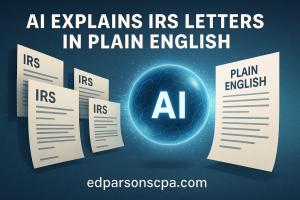IRS LETTER SURGE IN 2025 LEAVES MILLIONS CONFUSED; CPA LAUNCHES FREE AI ASSISTANT - A TAX GPT
IRS notices surge in 2025; CPA builds AI tool, like a tax GPT that decodes letters in plain English, cites IRS sources, provides action plan to avoid penalties.
The tool, a tax GPT, lets users enter the code from their IRS letter—such as CP14, CP59, or CP2000—and instantly see what it means, why it was issued, and the safest next steps. Each explanation includes a reference link to IRS.gov for verification.
Why It Matters
In 2025, the IRS has accelerated its notice mailings as part of stepped-up compliance and collections. Taxpayers are reporting a noticeable surge in letters such as CP14 balance-due notices, CP59 unfiled return reminders, CP2000 underreporting adjustments, and LT11 intent-to-levy warnings. Practitioner forums, tax blogs, and Reddit threads echo the same concern: even when notices are issued in error — like CP161 penalty letters sent to compliant filers — the burden still falls on taxpayers to interpret the codes, confirm accuracy, and respond before deadlines trigger additional penalties or enforcement.
The IRS has acknowledged that automated systems can generate incorrect notices, but acknowledgement alone does not resolve the confusion or reduce the stress taxpayers face when confronted with unfamiliar codes and intimidating deadlines. For individuals without professional representation, each new mailing represents both a financial risk and an emotional burden.
“Taxpayers don’t need jargon — they need clarity in 30 seconds,” said Edward Parsons, CPA. “This tax gpt mirrors how a professional would triage a notice: identify it, confirm it’s real, and outline the action plan. Instead of spending hours searching IRS.gov or waiting on hold with the IRS, a taxpayer can get a plain-English answer supported by official sources, then decide whether to self-resolve or escalate to a professional.”
By framing IRS letters in understandable language and linking directly to IRS.gov, the tool reduces uncertainty at a time when both taxpayers and practitioners agree: the volume of notices has become one of the most disruptive elements of tax practice in 2025.
Background
Experts note that IRS correspondence volume remains elevated, even as the agency implements modernization projects. According to Treasury’s Simple Notice Initiative, the IRS sends more than 150 million notices each year — ranging from balance-due statements to identity verification requests. While the initiative has promised redesigns to improve readability, the reality for most households has not changed: taxpayers continue to receive letters filled with legal codes, deadlines, and references that create stress and uncertainty.
Research shows that even a properly issued IRS letter can trigger disproportionate anxiety, with recipients often fearing audits, levies, or penalties before they have had a chance to understand the content. For lower-income families, language barriers and lack of access to professional advice compound the confusion. Practitioners report that a significant portion of their casework begins with clients simply not knowing whether a notice requires immediate action or can be safely resolved online.
The AI Tax Assistant was built to address this gap. Designed as a privacy-first tool, it requires no uploads of tax returns or supporting documents, and it does not collect Social Security numbers or personal identifiers. Users can simply type the notice code and a question to receive an immediate explanation. Every answer is paired with a direct link to the relevant IRS.gov source so taxpayers can confirm accuracy for themselves.
Recognizing the diversity of the taxpayer population, the tool also provides bilingual guidance in both English and Spanish — making it more accessible to households where English is not the primary language. For situations where a notice signals more complex problems, the system provides an on-ramp to professional support: taxpayers can optionally connect with a licensed CPA for further review, ensuring that those who need hands-on representation can get it without delay.
By bridging the gap between the IRS’s vast correspondence system and taxpayers’ everyday need for clarity, the tax gpt supports both transparency and peace of mind at a moment when confusion around IRS notices is at its peak.
Edward Parsons CPA
Edward Parsons CPA
+1 786-265-8578
edwardweb@edparsonscpa.com
Visit us on social media:
LinkedIn
X
A Tax GPT- IRS Problem Resolution AI Tax Assistant- Free Step By Step Guidance
Legal Disclaimer:
EIN Presswire provides this news content "as is" without warranty of any kind. We do not accept any responsibility or liability for the accuracy, content, images, videos, licenses, completeness, legality, or reliability of the information contained in this article. If you have any complaints or copyright issues related to this article, kindly contact the author above.

